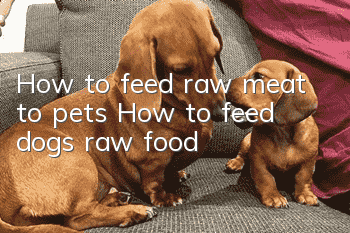How to feed raw meat to pets How to feed dogs raw food

Raw food should be the oldest "pet food" in the world. After all, dogs have always eaten "raw food" before they encountered humans. This is why in recent years, more and more people, especially in countries with relatively developed pet culture, have emphasized the importance of raw food for dog health and advocated owners to adopt raw food feeding methods. But in fact, feeding raw food is not as simple as we think. Changing to raw food feeding rashly is not only not beneficial to the health of dogs, but can even cause serious harm to them.
It is undeniable thatcurrent research has proven that raw food feeding is indeed very helpful to the health of dogs. It can improve the condition of dogs’ teeth and fur, and increase their energy levels.
But the risks are equally huge, especially for domestic breeders. More than 90% of breeders do not have the quality and ability to feed raw food. Both nutritional knowledge and professional skills are difficult. Meeting the requirements for raw food feedingand coupled with repeated food safety problems in the country,it is also difficult to guarantee the safety of ingredients for raw food feeding.
Raw food feeding is not just about "raw" food
"Raw food feeding is about feeding raw food". This sentence may sound correct at first, but in fact, raw food feeding is much more complicated. many. "Some pet owners consider putting a pound of raw meat in the food bowl as raw food." Dr. Judy Morgan is an authority on acupuncture and food therapy in the United States and a member of the American Naturopathic Veterinary Association. In his opinion, this feeding method is completely impossible to provide complete nutrition to dogs, but will increase the risk of diseases for dogs.
The main problem with this misunderstanding is that it only focuses on the dog’s needs for protein, fat and other nutrients, while ignoring the needs for minerals, vitamins and trace elements. Although the raw materials of raw food are indeed dominated by a large amount of meat, a nutritionally balanced and comprehensive raw food meal also needs to include a variety of supplementary materials, such as bones, offal, fruits, vegetables and some nutritional supplements. A diverse selection of ingredients can cover all the nutritional needs of dogs and maintain the balance of omega-3 and omega-6 in the dog's body.
Among these ingredients, the most easily overlooked by pet owners is fruit. We all know that eating some fruits every day has huge benefits for our bodies, but this understanding does not seem to extend to dogs. Many owners do not think that dogs need to consume fruits.to supplement nutrition. In fact, fruits are a very effective and important nutritional supplement for dogs fed raw food. Fruits not only provide dietary fiber and vitamins, but most of them are rich in natural antioxidants, which can help dogs fight against diseases in the body. inflammation and improve the dog’s resistance.
Safety risks may be greater than you think
Because domestic data on pet food safety is extremely limited, Dudu can only use the situation in the United States as an example.
According to AVMA statistics, the vast majority of chicken in the United States is contaminated with feces, and even so-called "food grade" raw meat carries the risk of spreading harmful bacteria. Common pathogens that may be present in meat include Salmonella, E. coli, and Campylobacter. Other pathogens may also contaminate raw meat, including Toxoplasma gondii (the parasite that causes toxoplasmosis), Cryptosporidium, Echinococcus, Clostridium, Neospora and Sarcocystis. If owners do not adequately process raw foods to eliminate contaminants, these pathogens can not only cause physical damage to pets, but can also be transmitted from pets to owners and their families. The FDA has also publicly stated that "the FDA does not believe that feeding undercooked pet food to animals is consistent with the goal of protecting the public from significant health risks."
In addition to pathogens, many toxic chemical residues in raw meat, such as heavy metals, hormones, drug residues, etc., are also serious safety risks. The American Veterinary Medical Foundation maintains a pet food recall database. In February 2018 alone, 38 products were recalled due to contamination, mainly from pentobarbital (a euthanasia drug) or salmonella contamination.
According to Dr. Richard Pitcairn, DVM, "By far the food sources with the most toxic chemicals are meat, bones, and other animal products like cheese, milk, etc. And those who eat these foods are at the top of the food chain. animal—people. In the United States, it’s humans and their pets.”
Although the domestic situation lacks support from real data, from the perspective of real-life conditions, the safety situation of domestic pet food and meat raw materials is not much more optimistic than that of the United States.
Professionalism is the foundation of health
The debate about raw food may continue. In fact, whether it is raw food, cooked food, or commercial dog food, if you want your dog to be healthy and happy, the owner’s The foundation of professional knowledge is the most important. No feeding method can be perfect, but the professional knowledge of the owner can help create a "perfect" menu for the dog.
- golden retriever genetic disease
- How to train the ferocity of a Rottweiler? How to train a Rottweiler!
- Prevention and care of dog diseases
- The fastest way to treat eczema in dogs
- Symptoms of dog poisoning
- What are the consequences of dogs drinking beer?
- How to train a Pomeranian to shake hands? Pomeranian life training guide!
- Dogs always like to be close to people. What should I do if they are too clingy to their owners?
- Causes of ovarian cysts in dogs | Diagnosis | Prevention and treatment methods
- Signs of fatal disease in dogs



